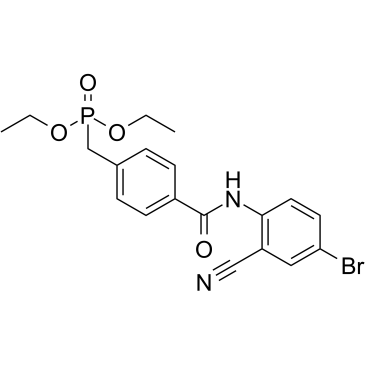Ibrolipim attenuates high glucose-induced endothelial dysfunction in cultured human umbilical vein endothelial cells via PI3K/Akt pathway.
Guohua Xiao, Zongbao Wang, Huaicai Zeng, Jian Yu, Weidong Yin, Sujun Zhang, Yueting Wang, Yali Zhang
Index: Pharmazie 66(10) , 798-803, (2011)
Full Text: HTML
Abstract
Endothelial dysfunction is a key event in the onset and progression of atherosclerosis associated with diabetes. Increasing cell apoptosis may lead to endothelial dysfunction and contribute to vascular complications. Therefore, we aimed to elucidate the possible role and mechanism of ibrolipim in preventing endothelial dysfunction induced by high glucose.Human umbilical vein endothelial cells (HUVECs) were cultured respectively under normal glucose level (5.5mM), high glucose level (33mM), and high glucose level with ibrolipim treatment. Endothelial dysfunction was identified by the expression of ET-1 and vWF through reverse transcription PCR (RT-PCR). HUVECs apoptosis was assessed by fluorescent staining with Hoechst 33258. Akt activity was analyzed by western blot.High glucose condition significantly increased the rate of apoptotic cells, weakened cell viability, and decreased the expression of ET-1 and vWF. Ibrolipim treatment significantly attenuated these alterations of endothelial dysfunction. The lower concentrations (2, 4, 8 microM) of ibrolipim inhibited apoptosis of cultured HUVECs, improved cell viability, down-regulated the mRNA levels of ET-1, vWF, and attenuated the cytotoxicity; however, higher concentration (16, 32 microM) of ibrolipim aggravated the damage of HUVECs cultured under high glucose level. Meanwhile, high glucose induced a decrease of Akt activity which led to apoptosis, and ibrolipim prevented the decrease and attenuated apoptotic effect induced by high glucose. Furthermore, the PI3K inhibitor LY294002 significantly abolished the anti-apoptotic effect of ibrolipim, and decreased Akt phosphorylation. Although, the expression of Akt mRNA and total protein were not altered in cultured HUVECs.Ibrolipim at lower concentrations can inhibit high glucose-induced apoptosis in cultured HUVECs, which might be related to the alternation of Akt activity. Ibrolipim has the potential to attenuate endothelial dysfunction and lower the risk of diabetes-associated vascular diseases. And it might be a therapeutic agent for diabetic vascular complications.
Related Compounds
| Structure | Name/CAS No. | Molecular Formula | Articles |
|---|---|---|---|
 |
Ibrolipim
CAS:133208-93-2 |
C19H20BrN2O4P |
|
Effects of NO-1886 on inflammation-associated cytokines in h...
2006-07-01 [Eur. J. Pharmacol. 540(1-3) , 139-46, (2006)] |
|
NO-1886 suppresses diet-induced insulin resistance and chole...
2010-01-01 [J. Endocrinol. 1st ed., 204 , 47-56, (2010)] |
|
Evaluation of induction potency of new drug candidates on CY...
2009-01-01 [Drug Metab. Pharmacokinet. 24(5) , 446-50, (2009)] |
|
NO-1886 (ibrolipim), a lipoprotein lipase-promoting agent, a...
2006-02-01 [Metab. Clin. Exp. 55(2) , 151-8, (2006)] |
|
NO-1886, a lipoprotein lipase activator, attenuates vascular...
2007-01-12 [Eur. J. Pharmacol. 554(2-3) , 183-90, (2007)] |